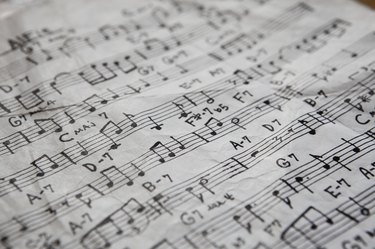
Named after Finnish composer Jean Sibelius, Sibelius is a music notation software that helps composers, educators and musicians of all kinds compose music. Whether you use Mac OS, Microsoft Windows or RISC OS, you can use Sibelius to compose, edit, print, scan, import and publish scores. If you do use Sibelius to compose, you may want to change the stem direction of notes to suit your personal sheet-music preferences.
Step 1
Select the note and choose the Edit option from the menu bar to reverse notes on the middle staff line, then select the Flip option. You can also select the note and press the letter X on your keyboard as a stem-flipping shortcut.
Video of the Day
Step 2
Select one of the notes and repeat the Step 1 process to flip the stems of multiple notes joined by the same beam (a thick line used to connect multiple notes). Do not use a note that has a stem direction that was changed by the addition of the beam. Follow the same process for beamed note groups with multiple voices.
Step 3
Change the stem direction for specific notes by editing the instrument. Go to the House Style menu bar option, then Edit Instruments, then Edit Staff Type, then Notes and Rests, then "Stems on notes in a single voice." Choose the appropriate option from the first two displayed: "Down for notes on middle staff line (or above)" or "Up for notes on middle staff line (or below)."
Step 4
Reverse the direction of all stems in a part by instrument regardless of pitch by choosing from the bottom two options: "Always down" or "Always up." Highlight a bar you wish to edit before clicking the House Style option if you want Sibelius 6 to automatically highlight the correct instrument in the dialogue box.
Video of the Day